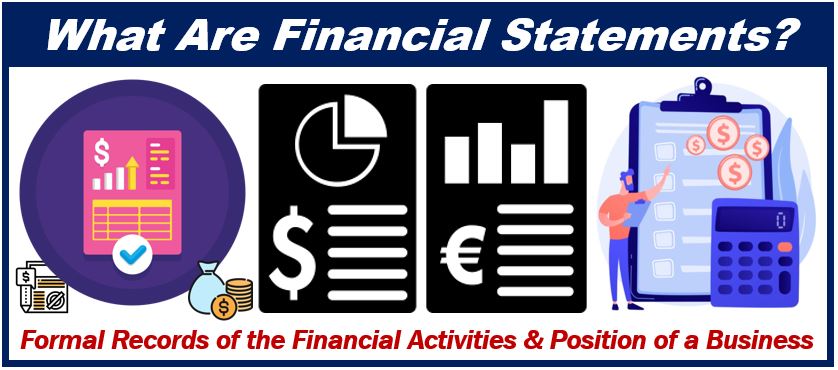External financial reporting, on a regular basis, is a crucial activity for any business nowadays. International Financial Reporting Standards “IFRS” and International Accounting standards “IAS” are the main references for external financial reporting of any business which seeks effective communication with various stakeholders such as investors, shareholders and regulatory authorities.
International standards have identified certain objectives for presenting the financial information, which includes providing relevant, reliable, comparable, and understandable information.

The Key Basic Financial Statements
Among the main components of any set of financial statements are the key basic financial statements namely: Statement of Financial Position, Statement of Income and Other Comprehensive Income, Statement of Cashflows, and Statement of Changes in Equity.
1. Statement of Financial Position
Statement of financial position has several presentation objectives for users of financial statements. A statement of financial position is always related to a specific point of time.
It provides the basic structure of the uses of funds (assets) and sources of funds (equity and liabilities). It reflects to users what an entity has and owes to others and its shareholders.
It gives crucial information about the segregation of assets and liabilities, between short term and long term, revealing the liquidity strength to repay liabilities mainly in the short term from available current liquid assets in addition to a description of categories of long-term assets.
Statement of financial position determines the adequacy of financing position and capital structure between debt and equity.
2. Statement of Income and Other Comprehensive Income
Statement of income and other comprehensive income has a different nature and important presentation objectives as well.
It represents activities during a period of time, but not at a specific point of time like the statement of financial position.
The major categories or streams are revenues and expenses whether direct or indirect, which reveal the profitability performance of any business during an economic cycle.
Accordingly, it specifies whether the profit or loss of the business is attributable to either its core activities, or to other non-recurring transactions occurring during the period.
Also, it displays separately additional unique expenses including cost of financing, taxes, foreign currency exchanges and results of discontinued operations.
On the other hand, the other comprehensive income section, which can be presented separately, represents the movement of an entity’s equity for element not related to the owner sources during specific period.
Other comprehensive income contains the unrealized gain or loss related to specific investments, foreign currency translation differences or adjustments related to derivatives used for hedging.
3. Statement of Cashflows
Statement of cashflows has a similar nature like statement of income, since it reflects activities over a period of time as well, not as at a specific time.
Statement of cashflows main presentation objective is to display how cash inflows and outflows can be segregated to 3 main categories, i.e. operating (or business performance), investing (or uses of funds) and financing (or sources of funds). Operating activities adjust non-cash gains or losses, before displaying the changes in current assets and liabilities.
While investing activities section displays cashflows resulting from changes in key investing decisions, like acquiring new assets or new subsidiaries, financing activities, on the other hand, reveal the major cashflows related to financing the entity either through debt or equity.
The financing activities includes debt proceeds, payments, lease payments, and incremental capital injected during the period by business owners.
4. Statement of Changes in Equity
Statement of changes in equity is related to a specific period of time. Its main objectives are mainly to show how each equity component moved from a period to another, and the nature of each movement.
Ideally, the net worth of any company would increase by profits for the year/period and decrease by dividends declared by owners of a Company or losses from operations.
Yet the presentation objectives of this statement particularly become urgent whenever there is a change in partners joining or exiting the Company.
The importance of presentation objectives elevates, as well for a Parent Company having multiple subsidiaries, along with non-controlling interest that involves step up and step down decisions, which are mainly changes in percentage of ownership of shares in the Parent Company.
Conclusion
Stakeholders are parties who deal with an entity or business either internally or externally. Accordingly, they are either direct or indirect beneficiaries of financial statements, and along with shareholders and other parties are collectively called users of financial statements.
Financial statements enable the users thereof to take relevant financial decisions. The quality of the financial statements may significantly enhance the quality of the financial decision making.
Also, it’s always better to use the basic financial statements comprehensively for decision making process, rather than a single statement.
As an example, whenever a credit analyst is analyzing a Company’s financial statements to decide whether the credit facility needs to be renewed or not, the net income for the Company may not be very attractive to cover the financing cost several times at the first look.
Yet when the statement of cashflows clearly identifies the adjustments to net income, revealing significant non-cash expenses like depreciation or amortization, which could hide the stable business operations for the Company that may justify the renewal of the facility requested by the Company.
Interesting related article: “What is an Accountant?“
